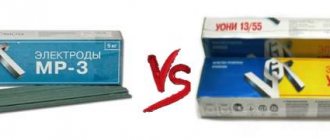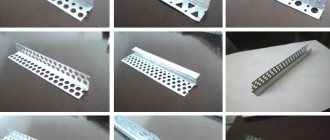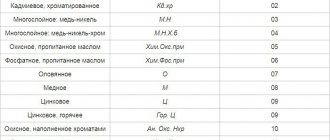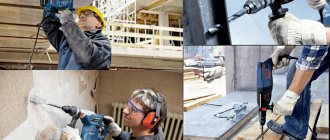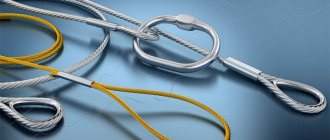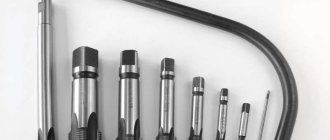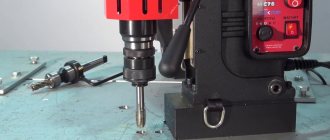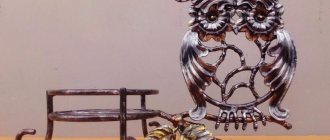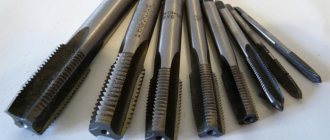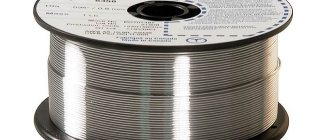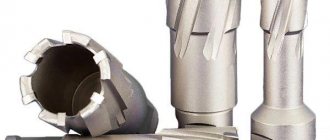Modern fasteners offer an impressive variety of sizes and are available in a variety of threads, but how do you choose the right products for a specific task?
When purchasing fasteners, consider the following characteristics:
- Pitch is the length between adjacent turns. The larger the pitch, the less solid the base material can be.
- External and internal diameters are the distance between the extreme edges of the external and, respectively, internal threads.
- Apex angle - this indicator is determined in degrees and is measured between the edges of the coil at the apex. The sharper the thread angle, the easier it will be to screw the fastener into the base.
Additionally, connecting products are distinguished by the following type of thread:
- internal;
- external.
Threads can also be metric or non-metric (inch). To prevent confusion with the measurement system in the international sales market, an appropriate conversion table for the operating parameters of connecting elements is used. For example, in America, fasteners are measured in inches, and in European countries - in millimeters. The table will always help you determine the exact size of the required fasteners.
| Caliber (number, size), indicating the diameter of the fastener in the inch measurement system | Inch-equivalent diameter of fastener in metric measurement system (mm) |
| #5 | 2.9 |
| #6 | 3.5 |
| #7 | 3.9 |
| #8 | 4.2 |
| #9 | 4.8 |
| #10 | 5.0 |
| #12 | 5.5 |
| #14 | 6.3 |
What kind of thread - small or large
For reliable fastening, you need to select bolts and nuts of a certain type. Only then will there be any questions regarding the quality of the connection. In particular, bolts with:
- large threads, if they corrode, then only slightly;
- fine threads are characterized by higher strength.
Note that the numerical characteristics of various types of thread are indicated in GOST 8742-2002, and its type - large pitch or small (denoted by P, measured in millimeters) - depends on the diameter of the rod (hereinafter referred to as Dst., unit of measurement - the same millimeters). This regulatory document establishes the minimum (min) and maximum (max) values of the parameter P. They are indicated in the following table.
| Fine thread | Large carving | ||
| D.st., mm | P, mm | D.st., mm | P, mm |
| min =1 | min = 0.2 | min = 0.25 | min = 0.075 |
| max = 600 | max = 8 | max = 68 | max = 6 |
Functional aspect and purpose of threaded connections
A screw thread is defined as a ridge of uniform helical cross-section on the outer or inner portions of a cylinder. The latter refers to nuts, and the former refers to bolts, studs or screws. In our online store “First Fasteners” you can buy stud bolts and screws with delivery to any region of Russia. The nut wholesale will have a price from the manufacturer.
Types of threaded connections are classified according to several parameters: • connection method: - direct; - connected by means of fasteners; • type of cutting profile: - inch, - trapezoidal, - metric, - cylindrical pipe, - round, thrust.
The thread form is the configuration in the axial plane or it is a profile consisting of a flange, root and flanks. There are ridges at the top of the threads, roots at the bottom, and the sides connect them. The triangle formed when the thread profile expands to a point at both the ridges and roots is the fundamental triangle. The height of the basic triangle is the radially measured distance between the ridge and the diameter of the root.
The distance measured parallel to the thread axis between corresponding points on adjacent threads is considered the thread pitch. Standardized screw threads are designated by the number of threads per inch of length. This is the number of complete cuts found in one inch. The metric cutting pitch is the distance from two adjacent turns in millimeters.
On an internal cut, the small diameter goes to the ridges, and the large diameter goes to the roots. If the thread is external, then the large diameter is located at the crests of the thread, and the small diameter is at the roots.
Flank (flank) angle is the angle between the flange and the perpendicular axis of the thread. Flank angles are sometimes called "half-angles" of a thread, but this is only true when adjacent flanks have the same angles, that is, the threads are symmetrical. The unified screw threads have a flange angle of 30° and are symmetrical. This is why they are commonly called 60 degree threads.
The pitch diameter is the diameter of the theoretical cylinder that passes through the thread such that the distance between the thread flanges and the roots is equal. When making a bolt and nut, a gap is intentionally created between the mating threads. This allowance is known as allowance.
The presence of an allowance ensures that when making threads there will be positive space between them. For fasteners, it is usually applied to external threads. Tolerances are certain amounts by which dimensions can be varied for ease of manufacture. This is actually the difference between the maximum and minimum legal limit.
This method of fastening individual parts has gained popularity because it has many advantages:
- high strength and long service life;
- the ability to create prefabricated/collapsible structures;
- simplicity and availability of tools for installation/disassembly;
- adjusting the tightening force;
- low weight and dimensions of the fastening element in relation to the mounted parts;
- a wide variety of types of connecting components.
Threaded connections are used for various purposes:
- ensuring tightness under internal or external fluid pressure;
- creating sufficient structural rigidity when transmitting external applied loads;
- forming good geometry so as not to increase the outer diameter or significantly reduce the inner diameter of a part of the structure.
Connections made using threads are reusable and can be used in various conditions. Connections based on welding or bonding methods, as well as snap-on connectors, are also available, but will not be discussed here.
For many years, threaded connections, with or without a resilient O-ring, have been the standard in household, construction and industrial applications. All connections that have one or more special characteristics, such as: higher strength, better sealing properties, faster recharge, smaller outer diameter of the coupling, internal streamlining and absence of recesses, etc., have been rapidly gaining popularity in recent years. Including the demand for stainless steel fasteners wholesale in Moscow has increased many times over.
Spontaneous weakening
A nut tightened on structural elements that are subject to increased vibrations and transverse loads during operation will unwind and, as professionals say, “slip” over time. To prevent this phenomenon, a self-locking nut with a flange (lock nut, slotted nut) should be used.
In this case, you should also pay attention to the force applied when screwing the threaded connection - the tightening torque. The value of this parameter depends on the strength class of the flange nut/bolt (indicated as a certain sequence of numbers) and the thread itself. The table below shows an example of only one strength class of such fasteners. Having studied the data contained in it, you will get an idea of the order of the numbers that apply to the tightening torque.
| Thread parameters | Tightening torque at strength class 8, Nm | |
| Nominal diameter, mm | Thread pitch, mm | |
| M12 | 1,75 | 98 +/- 12 |
| M10 | 1,5 | 55 +/- 10 |
| M8 | 1,25 | 27 +/- 5 |
| M6 | 1,0 | 12,+/-2 |
Metric fastening thread - Great Encyclopedia of Oil and Gas, article, page 1
Metric fastening thread
Page 1
Metric fastening threads with a sliding fit in accordance with GOST 9253 - 59 are designated by the initial letter of the thread name, the dimensions of the outer diameter and pitch and the accuracy class. The accuracy class of a thread (bolt or nut) is indicated by the letters class. In basic metric threads, the thread pitch is not indicated. [1]
Metric fastening threads with a profile angle of 60 according to GOST 8724 - 58 are divided into threads with large and fine pitches. [2]
Metric fastening threads are the main thread in our country and are used in all newly manufactured fasteners. [4]
For metric fastening threads according to OST 94 and 32 of the 1st accuracy class (2 - 68 mm), the tolerances of the outer diameter of the bolt are taken equal to 3 thread units. This accuracy class refers to only turned threads. [5]
For metric fastening threads, when checking them with limit gauges, when Ad2 b, the sliding fit changes to a transitional fit, in which a certain percentage of non-screwed threaded connections with interference are possible. [6]
For metric fastening threads OST 94 and 32 of the 1st accuracy class (2 - 68 mm), the tolerances of the outer diameter of the bolt are taken equal to 3 thread units. This class of accuracy refers to only turned carvings. [7]
Along with metric fastening threads, in 1927, an all-Union standard for inch threads with a profile angle of 55 according to the Whitworth system was approved, since the transition to metric threads for many industries could not be completed in a short period of time, and for the transition period it was necessary to establish unity thread profile with inch pitch. [8]
What profile does a metric fastening thread have? [9]
The most common is metric fastening threads, so this chapter discusses methods and means of checking this particular thread. [10]
Metric fastening threads are most often used. Let's look at the basic definitions of thread. A part with an internal thread is conventionally called a nut, a part with an external thread is called a bolt. [eleven]
So far, we have approved OST for ordinary metric fastening threads only for the 2nd and 3rd accuracy classes. [12]
The executive dimensions of gauges for checking metric fastening threads, inch threads, cylindrical pipe threads and trapezoidal threads are arranged in order of increasing diameters. [13]
In Fig. 260, o shows the profile of a metric fastening thread. [14]
In table 50 shows the cutting speeds when cutting external metric fastening threads with high-speed cutters EI262 on steel 45 with cooling according to the Ministry of Machine Tool Industry of the USSR with a tool life T of 60 min. [15]
Pages: 1 2
www.ngpedia.ru
Using Anchors
Today it is often found that inexperienced, novice home craftsmen attempt to use anchors for purposes other than their intended purpose. For example, their fastening is carried out contrary to the instructions on brick walls, which often causes:
- damage to the fastener itself, as well as to the nerves of the would-be master;
- after removing the anchor, very large holes are formed in the brick, spoiling the interior of the room.
To work with a brick surface, you should use such fasteners only of the appropriate type (an example for hollow brick is shown in the figure).
In general, it is recommended to use anchors when working with concrete structures. In softer materials, such bolts tend to spin. On the modern market you can find a large number of varieties of fasteners of this type for concrete. The table shows some technical characteristics of anchor bolts for working with such a surface of only the most common sizes.
| Designation | Pulling force (minimum), concrete B25, kN | Maximum torque when anchoring, Nm |
| 12×65 | 18,3 | 40 |
| 10×80 | 13,1 | 25 |
| 8×60 | 10,5 | 10 |
Image of thread on drawings
The threaded connection in the drawings is depicted conventionally. Thread profiles do not affect the designations; they will always be the same. Each type has its own nuances.
Thread designation on drawings
External is indicated on the outer part of the rod by a continuous thick line along the outer diameter and a thin line along the inner diameter. In a side view, it is indicated by a thin arcuate line equal to three quarters of a circle.
The internal diameter of the thread in the hole is indicated by thick lines, and the external diameter of the internal thread by thin lines.
Features of self-tapping screws
Modern industry produces self-tapping screws that can be screwed not only into wood and widely used plastic, but also into a metal base. A distinctive feature between the products is both the material of manufacture and, very importantly, the thread pitch. To screw fasteners into wood (as well as the aforementioned plastic), those with a large thread pitch are used. To work with metal surfaces, self-tapping screws with fine pitch threads are used.
Main settings
What is a threaded connection? The definition can take the following form - alternating peaks and valleys located along a helical line on the surface of a body of rotation.
Essential elements:
- Thread profile - contour of the thread section.
- Profile angle - the angle between the sides of the thread.
- The top of the profile is a part of the helical surface that connects adjacent sides along its top.
- The profile cavity is the part of the surface that connects adjacent sides along the bottom of the groove.
- Thread pitch is the interval between points on the sides of a profile located in the same plane.
- In addition, outer diameter, inner diameter and average diameter can be distinguished.
Below is a table with symbols:
| Parameter | Designation |
| Profile angle | B |
| Thread pitch | P |
| Internal thread diameter | d |
| Outer thread diameter | D |
Nails
In the minds of mature home craftsmen, nails are associated primarily with work on fastening wooden structures. Today on sale you can find such fasteners for driving into surfaces made of brick and concrete. They are manufactured using hardened steel. The modern building materials market offers the widest selection of fasteners. The selection of such products must be approached very carefully, taking into account their operating conditions, technical characteristics, and based on the technological features of the application.
| Tweet |
comments powered by Disqus
Types of threads
There are two main types of joints used in industry - detachable and permanent. The first types are obtained using fasteners, rivets, etc. One of the most common connections can be considered the first. The second types are performed using welding, soldering, and gluing. In practice, all these methods of joining parts are standardized.
It ensures the tightness of the connection without the use of any additional devices (washers, sealants, etc.). Using this type of connection dramatically reduces the time required to assemble/disassemble the connection. It can be found in supply systems for oil, fuel, steam, etc.
Inch tapered thread
It is most often used to connect elements included in fuel, oil and other pipelines. Not so long ago, it was standardized based on the inch system of measures.
The base is a triangle with an angle of 60⁰. But, in recent years, in practice they have begun to more often use a conical profile made on the basis of the metric system of measures.
Types of threads
During various construction works that involve the installation and disassembly of various structures, one often encounters the use of detachable threaded connections. Therefore, when selecting the necessary fasteners, you should pay attention to the type of thread. Its types and application features will be discussed below.
A thread is a spiral that has a constant pitch of turns and is made by cutting the fastening element used on the smooth surface of the rod. The first carving appeared in Ancient Greece and is successfully used today.
Tapered, round and trapezoidal threads
Conical parts differ from ordinary ones in that a conical thread is applied to their surface. The angle is 1/16. Such products are used when it is necessary to seal connections. Manufacturers must comply with the requirements specified in GOST 25229–85. To designate parts, the letter marking MK is used. After this there are numerical parameters that correspond to geometric indicators.
The round profile is used in the manufacture of various pipeline valves and other shut-off valves. All standards for this type can be found in GOST 13536–68. In documentation, drawings and diagrams, the designation of the letters Kr is used. The angle near the top of the turns is 30 degrees.
The peculiarity of trapezoidal threads is that they are self-tapping. As the nut moves, a very high frictional force is created. Thanks to this, no additional fixation is required. Products of this type are produced in sizes 8–640 mm. The pitch of the turns varies from 1.5 to 12 mm. All requirements for finished parts are specified in GOST 24738−81.
